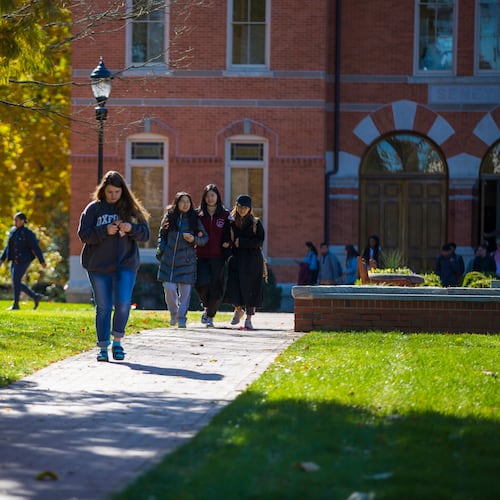Jim Laney was thinking big when he became Emory University’s president in 1977.
The former dean of Emory’s theology school made a list of goals — more student scholarships, new buildings, additional professors — and estimated it would cost $165 million.
Laney found a somewhat surprising benefactor: Robert W. Woodruff, a middling Emory student who dropped out decades earlier, but still carved out a pretty successful 62-year career, first as president, and later chairman, of Coca-Cola.
In November 1979, Woodruff and his younger brother, George, announced what’s now called “The Gift.” They donated 3 million shares of Coca-Cola stock, then valued at $105 million, to Emory. At that time, it was the largest contribution to a school in American history. Laney comfortably made his fundraising goal.
The Coca-Cola shares transfer was completed 40 years ago this month, and Emory has scheduled a program Tuesday to celebrate. Emory leaders are hoping to connect current and former students who received scholarships from “The Gift,” in part, to brainstorm ways to help local nonprofits and address local issues such as assisting military veterans. Public service remains a goal of the student scholarship program that came from the Woodruff gift. In general, scholars are not required to do community service, but it is encouraged.
“Our focus is creating community,” said Catie Miller, Emory’s senior associate director of advancement and alumni engagement.
The donation changed college philanthropy nationally. Emory’s enrollment rose by 40% over the next 12 years, and is now 15,398 students — nearly twice what it was in 1980. It became a leader in health research. Emory’s endowment — money donated to a university to support its projects or scholarships — is approximately $7.9 billion, the second-largest in the South, according to a recent report. Emory is often ranked among the nation’s top 25 academic universities.
“It was a vote of confidence,” said Laney, 92, who left Emory in 1993 and later became a U.S. ambassador to South Korea. “It felt like we were confirmed.”
About 2,900 undergraduate and graduate students have received Robert W. Woodruff scholarships and fellowships, which pay for full tuition, fees, and on-campus room and board. This year’s total is 273 students.
The Woodruff acceptance rate at some of Emory’s schools is about 5%, officials said. Students are selected based on their academic credentials and leadership skills. Many students say they couldn’t afford an Emory education without it. This year’s undergraduate tuition is about $53,000, nearly twice that of the out-of-state cost to attend the University of Georgia. Emory’s on-campus room and board and fees are an additional $19,000.
Alpa Sutaria received a scholarship to attend Emory’s business school and graduated in 1996. Sutaria said she chose Emory, in part, because of the Woodruff scholarship’s desired goals of educating future leaders committed to community service.
“It spoke to the why for me about why I was going to grad school,” Sutaria said.
Sutaria, now a vice president at Coca-Cola, also spends time involved in educational enrichment opportunities in the area. She knows several former scholars doing community service. One is involved with a Boys & Girls Club. Another started a nonprofit that supports military veterans.
Sutaria hopes this month’s celebration will be an opportunity for current and former scholars to think about ways to address longstanding issues in metro Atlanta like homelessness or human trafficking.
“I think it could really be a powerful force to drive change,” she said.
Several current students have similar goals of helping others.
Fourth-year student Yasmeen Shahout, 22, is on the pre-med track at Emory and passionate about expanding health care access. She volunteers at a clinic in Duluth. Her work includes interpreting in Arabic and Spanish for patients.
Shahout, who grew up in east Cobb, said Emory was her dream school since she was 8, but she wondered if she could afford it. Shahout, a first-generation college student of Syrian heritage, earned a Woodruff scholarship.
“It was an absolute shock,” said Shahout, who asked someone to reread the acceptance email. “It was a dream come true.”
Silas Allard, 37, is a two-time recipient of Woodruff fellowships. His current fellowship pays his tuition to pursue a degree in its graduate division of religion. The Missouri native is a teaching assistant there. Allard’s prior fellowship paid his way through Emory’s law school.
Allard said some friends who became attorneys are unable to do pro bono work because they’re focused on repaying student loan debt. The fellowship freed Allard from such worries. He’s thankful for what he describes as “the investment the university has made in me.”
Woodruff’s goal with the gift was largely to increase the capabilities of Emory, and Atlanta, to address major societal and health care issues. Things changed quickly at Emory. The scholarships and fellowships were created in 1980. Jimmy Carter joined the faculty in 1982, a year after leaving the White House. By 1990, Emory doubled its space for life science research and opened a museum of art and archaeology.
Woodruff’s contributions to Emory began long before “The Gift.” He enrolled at what was then called Emory College in Oxford, located near Covington, in 1908. (It’s now called Oxford College of Emory University.) His education did not go well. The college’s president, James E. Dickey, wrote a letter to Woodruff’s father in February 1909 recommending he not return.
“He has never learned to apply himself, which together with his frequent absences makes it impossible for him to succeed as a student,” Dickey wrote.
Woodruff left and worked as a laborer at several companies before finding his way at one firm. He became Coca-Cola’s president when his father bought the beverage company in 1922.
Woodruff did not hold a grudge toward Emory. Mr. Woodruff, as he’s still called around the university, quickly supported Laney’s idea. Woodruff, who avoided the spotlight, didn’t attend the ceremony announcing the gift.
Laney said he occasionally met with Woodruff to give updates on how the donation was being used. Woodruff died in 1985. A statue of him stands in front of the university’s library.
Russ Hardin, president of the Woodruff Foundation, an organization separate from Emory that gave about $131 million last year in grants to other colleges and organizations throughout Atlanta, said Woodruff wanted Emory to become a "world-class university." Woodruff was quite competitive, Hardin said. The foundation gave Emory $400 million in 2018 for medical research, now the university's largest single gift.
“He wanted Atlanta to be a big-league city and a good place to do business and a good place to live,” Hardin said. “He wanted Emory to play a role in that.”
============
Why who gets endowment cash draws scrutiny
American colleges and universities are getting more money in donations, but much of the big money goes to schools that already have large bank accounts.
In all, U.S. institutions of higher education received $49.6 billion in donations last year, a 6% increase, a January report by the Council for Advancement and Support of Education found.
Harvard University, which has the nation’s largest higher education endowment, $39.4 billion by one account, received $1.4 billion in donations in 2018, according to media reports. Media magnate turned Democratic Party presidential candidate Michael Bloomberg in 2018 committed $1.8 billion to Johns Hopkins University, which is now the largest gift ever to a U.S. college or university.
The U.S. schools with the 20 largest endowments, which include Emory, have as much in their endowments (about $310 billion) as the next 440 schools combined, data shows from another January report by the National Association of College and University Business Officers and TIAA-CREF.
There’s been more conversation and greater scrutiny in recent years about the disparity.
“It’s really dramatically unequal,” said Will Doyle, a Vanderbilt University higher education professor who’s done research on the topic. “The places that have the most money get the most money.”
Those schools are also the most expensive to attend and toughest to get into. Thirteen of those 20 schools with the largest endowments cost more than $70,000 a year. And, Doyle said, they’re in steep competition to maintain high admissions standards in order to stay atop prestigious national academic rankings, which results in more money from donors in search of a sure thing.
The priorities of donors can change quickly and drastically, said Linda Durant, CASE’s vice president of development. More donors are interested in needs-based giving, she said, along with gifts to liberal arts colleges.
About one-third of donations to U.S. colleges last year came from foundations. Twelve donations from foundations exceeded $100 million between 2013 and 2018, CASE’s research shows.
Durant called the 1979 Woodruff contribution to Emory a “transformational gift.”
“That’s still a lot of money,” she said.
Doyle credits Emory for “The Emory Advantage,” a program that aims to lower costs for students from families with annual incomes below $100,000. Most selective schools, he said, do not offer robust needs-based aid programs.
Doyle would like to see the federal government or states provide matching grants to colleges that offer needs-based aid. The University of Georgia announced last month a program started in 2017 to provide help to low-income students has awarded scholarships to more than 500 students.
The program, which has now raised $77 million, began with $30 million. The initial money came from the Robert W. Woodruff Foundation.
About the Author
Keep Reading
The Latest
Featured









